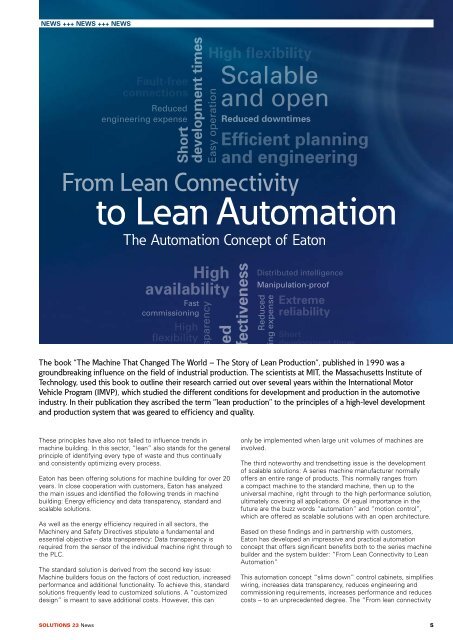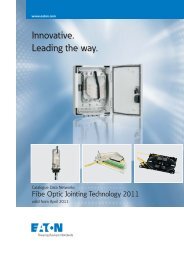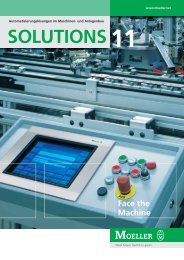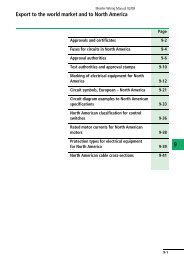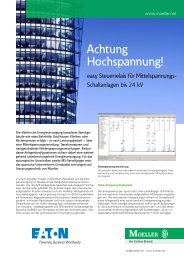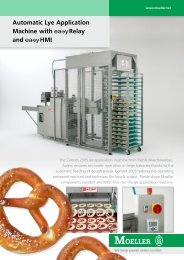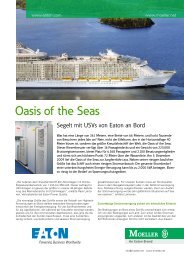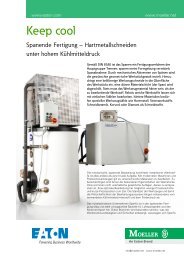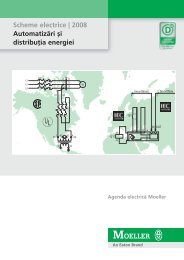Export Requirements for Packaging Machines - Moeller
Export Requirements for Packaging Machines - Moeller
Export Requirements for Packaging Machines - Moeller
You also want an ePaper? Increase the reach of your titles
YUMPU automatically turns print PDFs into web optimized ePapers that Google loves.
NEWS +++ NEWS +++ NEWS<br />
The book “The Machine That Changed The World – The Story of Lean Production”, published in 1990 was a<br />
groundbreaking influence on the field of industrial production. The scientists at MIT, the Massachusetts Institute of<br />
Technology, used this book to outline their research carried out over several years within the International Motor<br />
Vehicle Program (IMVP), which studied the different conditions <strong>for</strong> development and production in the automotive<br />
industry. In their publication they ascribed the term “lean production” to the principles of a high-level development<br />
and production system that was geared to efficiency and quality.<br />
These principles have also not failed to influence trends in<br />
machine building. In this sector, “lean” also stands <strong>for</strong> the general<br />
principle of identifying every type of waste and thus continually<br />
and consistently optimizing every process.<br />
Eaton has been offering solutions <strong>for</strong> machine building <strong>for</strong> over 20<br />
years. In close cooperation with customers, Eaton has analyzed<br />
the main issues and identified the following trends in machine<br />
building: Energy efficiency and data transparency, standard and<br />
scalable solutions.<br />
As well as the energy efficiency required in all sectors, the<br />
Machinery and Safety Directives stipulate a fundamental and<br />
essential objective – data transparency: Data transparency is<br />
required from the sensor of the individual machine right through to<br />
the PLC.<br />
The standard solution is derived from the second key issue:<br />
Machine builders focus on the factors of cost reduction, increased<br />
per<strong>for</strong>mance and additional functionality. To achieve this, standard<br />
solutions frequently lead to customized solutions. A “customized<br />
design” is meant to save additional costs. However, this can<br />
SolutionS 23 News<br />
Fault-free<br />
connections<br />
Reduced<br />
engineering expense<br />
High flexibility<br />
Short<br />
development times<br />
Data transparency<br />
Easy operation<br />
Improved<br />
cost-effectiveness<br />
Reduced<br />
engineering expense<br />
Scalable<br />
and open<br />
Reduced downtimes<br />
The Automation Concept of Eaton<br />
High<br />
availability<br />
Fast<br />
commissioning<br />
Efficient planning<br />
and engineering<br />
From Lean Connectivity<br />
to Lean Automation<br />
High<br />
flexibility<br />
Distributed intelligence<br />
Manipulation-proof<br />
Extreme<br />
reliability<br />
Short<br />
development times<br />
only be implemented when large unit volumes of machines are<br />
involved.<br />
The third noteworthy and trendsetting issue is the development<br />
of scalable solutions: A series machine manufacturer normally<br />
offers an entire range of products. This normally ranges from<br />
a compact machine to the standard machine, then up to the<br />
universal machine, right through to the high per<strong>for</strong>mance solution,<br />
ultimately covering all applications. Of equal importance in the<br />
future are the buzz words “automation” and “motion control”,<br />
which are offered as scalable solutions with an open architecture.<br />
Based on these findings and in partnership with customers,<br />
Eaton has developed an impressive and practical automation<br />
concept that offers significant benefits both to the series machine<br />
builder and the system builder: “From Lean Connectivity to Lean<br />
Automation”<br />
This automation concept “slims down” control cabinets, simplifies<br />
wiring, increases data transparency, reduces engineering and<br />
commissioning requirements, increases per<strong>for</strong>mance and reduces<br />
costs – to an unprecedented degree. The “From lean connectivity<br />
5


